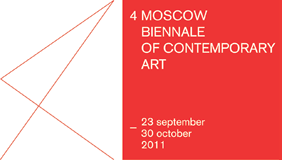4th Moscow Biennale 2011
23 Sep - 30 Oct 2011
23 September - 30 October 2011
Curators:
Joseph Backstein
Peter Weibel
On September 22, the Moscow Biennale of Contemporary Art opens its fourth edition. Titled “Rewriting Worlds,’’ it will run until October 30 and features 64 artists and 14 groups of artists from more 33 countries. The Moscow Biennale will be curated by Peter Weibel, Director of ZKM in Karlsruhe, Germany.
Among famous names of the international art scene the Main project will feature artists such as Martin Walde (Australia), Ai Weiwei (China), Richard Hamilton (UK), Manabu Ikeda (Japan), Ken Lum (Canada) and Zheng Shengtian (China), Fabián Marcaccio (Argentina/USA), Walid Ra'ad (Lebanon/USA), Neo Rauch (Germany), Claire Fontaine (France), Susan Hiller (UK/USA), Rebecca Horn (Germany), Christoph Schlingensief (Germany), Olafur Eliasson (Denmark/Germany), Michael Elmgreen (Denmark) Ingar Dragset (Norway) and many others.
Commenting on the final list of artists of the Main project Peter Weibel said: “As you can see, we have made a selection of artists ranging from Chile to China, from Ukraine to the USA, from Austria to Indonesia. That means a real global selection of contemporary art. These artists are partially famous and established artists like Richard Hamilton or Gerhard Richter, but many are not famous yet (like Nadezhda Anfalova) but all of them are making an important contribution to the transformations of contemporary art. The exhibition includes all the media, i.e.: classical media like painting and sculpture but also computer-assisted media installations and sound art”.
Russian artists will have an active part in the Biennale, exhibiting works by the Blue Soup, Electroboutique, Learning Film, as well as artists Valery Chtak, Alina Gutkina, Olga Kisseleva, Taisiya Korotkova, Taus Makhacheva, Yelena Yelagina and Igor Makarevich and others.
“Studying about 300 portfolios of Russian artists I saw a tendency for "decompression" and "deframing". In the soviet time the former generation of artists withdrew from public places to private rooms to preserve and to protect the autonomy of the artwork. By doing this they already "deframed" the artwork as a closed system and turned it into a collective experience. They in effect changed the autonomy of the artwork and also the public. The best artists of the contemporary generation benefit from this launch” – says Peter Weibel.

